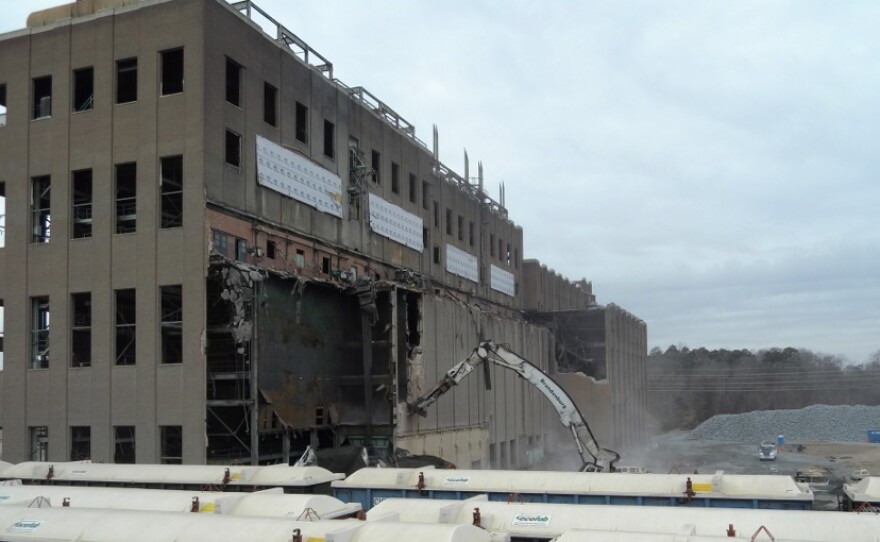A big transformation is happening at Duke Energy's retired Riverbend Steam Station on Mountain Island Lake northwest of Charlotte. The 1920s powerhouse is being demolished, wall-by-wall. And trains are hauling away coal ash that had been dumped behind the plant for about 90 years.
The tall metal smokestacks are gone - pulled down in December. Now workers are demolishing the exterior walls using long-armed excavators with special attachments.
“You probably see an attachment that they call their brick pick. It's used to take the brick off the building,” demolition manager Ronnie Goodman said as he explained the demolition this week. “It has a grapple which is used for grabbing the debris and then they also use a shear. A shear is used for cutting the steel. You'll see a lot of this structure come down with that shear.”

For the past few weeks, workers have been chipping away at the rear of the plant, pulling out metal and knocking down sections of brick walls. The next big milestone will come in a couple of weeks, when the massive old boilers are demolished.
Lanford Reid came out of retirement to help oversee this work. He worked at Riverbend for 40 years before it shut down in 2013 - much of that time as a plant controller.
“Anything that had to be done the plant would produce electricity, that's what we did,” Reid said. “Whether it was anything from working in the pump room to supply water or just making sure coal was in a boiler to get to the boiler in order to burn it.”
A WORKHORSE FROM THE PAST
Riverbend opened on the banks of the Catawba River in 1929. Its boilers burned coal that heated water to produce steam. The steam spun turbines to generate electricity for the Charlotte region.
Bob Drum was also a longtime plant operator, and was at the plant this week to watch the demolition. He recalled that the work was hard and hot.

“You just think about the interior of a power plant with a boiler sitting in the middle of the building there itself in July or August and you know the temperatures that are just radiated from all that equipment and when something breaks it has to be repaired,” Drum said.
He’s sorry to see the plant come down. “It's sad. It really is,” he said.
Drum pointed out that Riverbend provided a livelihood for many people over the years - 145 employees at its peak. The site even once had a neighborhood of small houses for employees, until they were removed a few decades ago.
Now the plant itself is going away. When the demolition is finished this summer, workers will grade and landscape the site.
“If you come back a year from now, most everything down there will be green grass and there'll be very little evidence the plant was ever here,” Goodman said.
HAULING AWAY COAL ASH
Green grass is also the ultimate goal for the other major project going on at Riverbend right now - removal of about 5 million tons of coal ash dumped near Mountain Island Lake.
Coal ash is what's left after burning coal. It contains lead, arsenic, mercury and other elements that can be hazardous in high concentrations.
Excavators have been digging up the gray muddy earth seven days a week since I last visited in early 2016. This time, I didn't recognize the place. Project manager Chris Varner explained why.
“So when we started we were about 30 feet higher than where we're standing today. It was all ash that was placed during previous ash basin clean-outs,” Varner said.
The coal ash is loaded into 85-car trains that haul coal ash every other day to an old brick mine in Chatham County, in central North Carolina, where it's being used as fill.
State law requires Duke to remove all the ash at Riverbend by Aug. 1, 2019. The company is currently seeking rate increases to pay for cleanups here and at its other coal plants in the state - though the request has met heavy opposition from customers and environmentalists. State regulators will have to decide if Duke is right to pass cleanup costs along to customers.
Bob Drum said he never thought about how Duke handled coal ash. He said Duke was just doing what was acceptable at the time.
“You know, there weren't any other concerns about it. I mean, we just placed it out there in the ash basins. It's what we were legally allowed to do and that's how we disposed of it, so … I never personally had any concerns about it. I spent a lot of time around fly ash,” Drum said.
So far, nearly four million of the five million tons of ash at Riverbend have been hauled off. The rest will be gone by the end of the year, Varner said.
As with the old plant, the former coal ash dump will be landscaped.
“We’ll do some final grading to restore the grades to gentle slopes. And we'll do some grass seeding and so on,” he said.
When it’s done, he said, “It will look like rolling green pastures.”
That will look much like it did a century ago - before the coal era in North Carolina.
RELATED LINK
Duke-Energy.com web page on decommissioning of coal plants









